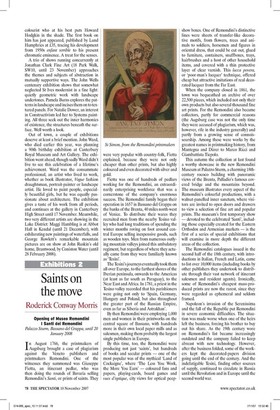Saints on the move
Roderick Conway Morris Opening of Museo Remondini I Santi dei Remondini Palazzo Sturm, Bassano del Grappa, until 20 January 2008 In August 1766, the printmakers of Augsburg brought a case of plagiarism against the Veneto publishers and printmakers Remondini. One of the witnesses they summoned was Giuseppe Fietta, an itinerant pedlar, who was then doing the rounds of Bavaria selling Remondini's Santi, or prints of saints. They were very popular with country-folk, Fietta explained, because they were not only cheaper than other prints, but also highly coloured and even decorated with silver and gold.
Fietta was one of hundreds of pedlars working for the Remondini, an extraordinarily enterprising workforce that was a cornerstone of the company's enormous success. The Remondini family began their operation in 1657 in Bassano del Grappa on the banks of the Brenta, 40 miles north-west of Venice. To distribute their wares they recruited men from the nearby Tesino valley who had long traditions of spending the winter months roving on foot around central Europe selling inexpensive goods, such as wooden toys. Men from numerous outlying mountain valleys joined this ambulatory regiment, but regardless of where they actually came from they were familiarly known as `Tesinf The Tesini's journeys eventually took them all over Europe, to the farthest shores of the Iberian peninsula, onwards to the Americas (at least as far south as Paraguay), to the Near East and Africa. In 1781, a priest in the Tesino valley recorded that his parishioners were going not only to 'Spain, Germany, Hungary and Poland, but also throughout the greater part of the Russian Empire, even as far as Siberia and Astrakhan'.
By then Remondini were employing 1,000 men and women in their printworks on the central square of Bassano, with hundreds more in their own local paper mills and as salesmen, making them probably the largest single publishers in Europe.
By this time, too, the Remondini were producing not just 'saints', but hundreds of books and secular prints — one of the most popular was of the mythical 'Land of Cockaigne', where 'The Less You Work, the More You Earn' — coloured fans and papers, playing-cards, board games and vues d'optique, city views for optical peepshow boxes. One of Remondini's distinctive lines were sheets of transfer-like decorative motifs, from flowers, trees and animals to soldiers, horsemen and figures in oriental dress, that could be cut out, glued to furniture, containers, snuffboxes, trays, hairbrushes and a host of other household items, and covered with a thin protective layer of clear varnish. This lacca povera, or 'poor-man's lacquer' technique, offered cheap but attractive imitations of real decorated lacquer from the Far East.
When the company closed in 1861, the town was bequeathed an archive of over 22,500 pieces, which included not only their own products but also several thousand fine art prints. For the Remondini also became collectors, partly for commercial reasons (the Augsburg case was not the only time they were accused of plagiarism, which was, however, rife in the industry generally) and partly from a growing sense of connoisseurship. Among these were works by the greatest names in printmaking history, from Mantegna and Darer to Marco Ricci and Giambattista Tiepolo.
This autumn the collection at last found a worthy showcase in the new Remondini Museum at Palazzo Sturm, a charming 18thcentury rococo building with panoramic views of the Brenta, Palladio's famous covered bridge and the mountains beyond. The museum illustrates every aspect of the Remondini's colourful productions, with a walnut-panelled inner sanctum, where visitors are invited to open doors and drawers to view a selection of fine art and popular prints. The museum's first temporary show — devoted to the celebrated 'Sand', including those especially created for the Eastern Orthodox and Armenian markets — is the first of a series of special exhibitions that will examine in more depth the different areas of the collection.
The Remondini catalogues issued in the second half of the 18th century, with introductions in Italian, French and Latin, came to list over 10,000 items (including books by other publishers they undertook to distribute through their vast network of itinerant salesmen and resident agents). Ironically, some of Remondini's cheapest mass-produced prints are now the rarest, since they were regarded as ephemeral and seldom framed.
Napoleon's invasion of the Serenissima and the fall of the Republic put Remondini in severe economic difficulties. The situation was made worse when one of the heirs left the business, forcing his brother to buy out his share. As the 19th century wore on Remondini's list became increasingly outdated and the company failed to keep abreast with new technology. However, after the business folded, some of the workers kept the decorated-papers division going until the end of the century. And the indefatigable Tesini, finding other sources of supply, continued to circulate in Russia until the Revolution and in Europe until the second world war.





































































 Previous page
Previous page